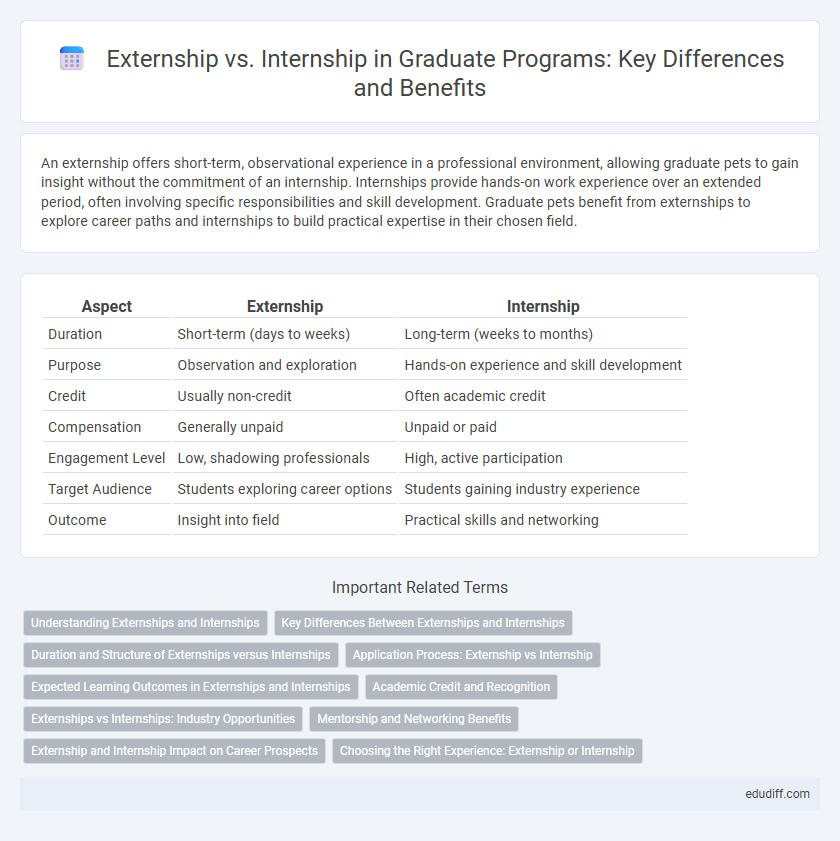An externship offers short-term, observational experience in a professional environment, allowing graduate pets to gain insight without the commitment of an internship. Internships provide hands-on work experience over an extended period, often involving specific responsibilities and skill development. Graduate pets benefit from externships to explore career paths and internships to build practical expertise in their chosen field.
Table of Comparison
| Aspect | Externship | Internship |
|---|---|---|
| Duration | Short-term (days to weeks) | Long-term (weeks to months) |
| Purpose | Observation and exploration | Hands-on experience and skill development |
| Credit | Usually non-credit | Often academic credit |
| Compensation | Generally unpaid | Unpaid or paid |
| Engagement Level | Low, shadowing professionals | High, active participation |
| Target Audience | Students exploring career options | Students gaining industry experience |
| Outcome | Insight into field | Practical skills and networking |
Understanding Externships and Internships
Externships provide short-term, immersive experiences allowing graduates to observe professionals in real workplace settings, often lasting days to weeks. Internships involve longer commitments, typically several months, offering hands-on tasks and skill development in a specific industry. Both opportunities enhance career readiness, but externships emphasize exploration while internships focus on practical application and networking.
Key Differences Between Externships and Internships
Externships offer short-term, observational experiences primarily designed to provide students with a glimpse into a professional field, whereas internships involve longer-term, hands-on work assignments that contribute to skill development and resume building. Internships often include structured projects, mentorship, and the possibility of earning academic credit or compensation, unlike externships which are generally unpaid and less immersive. Understanding these distinctions helps graduates choose the appropriate practical experience aligned with their career goals and educational requirements.
Duration and Structure of Externships versus Internships
Externships typically last from one day to two weeks, offering a short-term, observational experience that allows graduates to explore a profession and gain insight into the work environment. Internships usually span several months, often aligning with academic semesters or summer breaks, providing hands-on, practical work experience with structured learning objectives. The structured nature of internships includes regular supervision, assignments, and evaluations, whereas externships emphasize shadowing professionals and brief exposure without extensive responsibilities.
Application Process: Externship vs Internship
The application process for externships typically involves shorter commitments with streamlined selection criteria, focusing on observational and shadowing experiences, whereas internships require more formal applications, often including resumes, cover letters, and interviews to assess candidates for hands-on roles. Externship programs usually accept applications year-round or on a rolling basis, while internships follow structured timelines aligned with academic semesters or summer breaks. Understanding these distinct application procedures helps graduates strategically target opportunities that match their career goals and availability.
Expected Learning Outcomes in Externships and Internships
Externships provide graduate students with observational learning experiences that emphasize exposure to professional environments, allowing them to understand industry workflows and culture. Internships offer hands-on, practical application of skills with direct contributions to projects, fostering competence and professional development in specific roles. Both experiences enhance resume credentials, but internships typically yield deeper skill acquisition and measurable outcomes relevant to career readiness.
Academic Credit and Recognition
Externships typically provide direct academic credit and official recognition within university programs, enhancing a graduate's academic transcript and professional portfolio. Internships may offer academic credit depending on the institution's policies, but they are more commonly valued for practical work experience rather than formal academic acknowledgment. Graduate students should verify their school's specific credit transfer agreements and recognition criteria to maximize the externship or internship benefits.
Externships vs Internships: Industry Opportunities
Externships provide graduates with short-term, observational experiences in industry settings, offering valuable exposure to professional environments without long-term commitments. Internships typically involve hands-on work responsibilities, often lasting several months, and may lead to direct employment opportunities within companies. Industry opportunities through externships allow students to explore multiple sectors quickly, while internships offer deeper skill development and networking within a specific field.
Mentorship and Networking Benefits
Externships offer graduate students direct mentorship opportunities, enabling close guidance from industry professionals during short-term, intensive experiences. Internships provide extended exposure to workplace environments, fostering broader networking connections through longer-term team collaboration and project involvement. Both paths enhance career growth, but externships emphasize personalized mentorship, while internships prioritize comprehensive networking benefits.
Externship and Internship Impact on Career Prospects
Externships provide hands-on experience and networking opportunities by exposing graduates to real-world work environments, enhancing their understanding of industry expectations. Internships offer in-depth skill development and often lead to potential job offers, significantly boosting employability and career advancement. Both experiences complement each other and increase a graduate's marketability in competitive job markets.
Choosing the Right Experience: Externship or Internship
Graduate students deciding between an externship and an internship should evaluate their career goals and desired level of workplace immersion. Externships typically offer short-term, observational experiences providing exposure to professional environments without extensive hands-on work, ideal for exploring industries. Internships involve longer-term, practical roles that develop specific skills and include direct contributions to projects, making them suitable for building a professional portfolio and gaining in-depth knowledge.
Externship vs Internship Infographic

 edudiff.com
edudiff.com